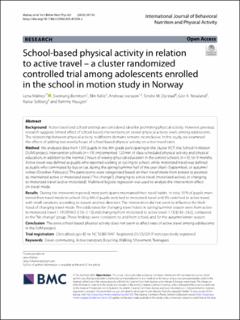School-based physical activity in relation to active travel – a cluster randomized controlled trial among adolescents enrolled in the school in motion study in Norway
Malnes, Lena; Berntsen, Sveinung; Kolle, Elin; Ivarsson, Andreas; Dyrstad, Sindre Mikal; Resaland, Geir Kåre; Solberg, Runar Barstad; Haugen, Tommy
Peer reviewed, Journal article
Published version

View/
Date
2023Metadata
Show full item recordCollections
Original version
Malnes, L., Berntsen, S, Kolle, E., Ivarsson, A., Dyrstad, S. M., Resaland, G. K., Solberg, R. B. & Haugen, T. (2023). School-based physical activity in relation to active travel – a cluster randomized controlled trial among adolescents enrolled in the school in motion study in Norway. International Journal of Behavioral Nutrition and Physical Activity, 20, 1-8. https://doi.org/10.1186/s12966-023-01534-xAbstract
Background Active travel and school settings are considered ideal for promoting physical activity. However, previous research suggests limited efect of school-based interventions on overall physical activity levels among adolescents. The relationship between physical activity in diferent domains remains inconclusive. In this study, we examined the efects of adding two weekly hours of school-based physical activity on active travel rates. Method We analyzed data from 1370 pupils in the 9th-grade participating in the cluster RCT; the School In Motion (ScIM) project. Intervention schools (n=19) implemented 120min of class-scheduled physical activity and physical education, in addition to the normal 2 hours of weekly physical education in the control schools (n=9), for 9 months. Active travel was defned as pupils who reported walking or cycling to school, while motorized travel was defned as pupils who commuted by bus or car, during the spring/summer half of the year (April–September), or autumn/ winter (October–February). The participants were categorized based on their travel mode from pretest to posttest as; maintained active or motorized travel (“No change”), changing to active travel (motorized-active), or changing to motorized travel (active-motorized). Multilevel logistic regression was used to analyze the intervention efect on travel mode. Results During the intervention period, most participants maintained their travel habits. In total, 91% of pupils maintained their travel mode to school. Only 6% of pupils switched to motorized travel and 3% switched to active travel, with small variations according to season and trip direction. The intervention did not seem to infuence the likelihood of changing travel mode. The odds ratios for changing travel habits in spring/summer season were from active to motorized travel 1.19 [95%CI: 0.53–2.15] and changing from motorized to active travel 1.18 [0.30–2.62], compared to the “No change” group. These fndings were consistent to and from school, and for the autumn/winter season. Conclusion The extra school-based physical activity does not seem to afect rates of active travel among adolescents in the ScIM project.
